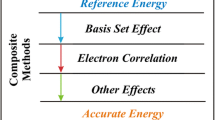Abstract
Calculations of lattice self-potentials and lattice potentials were made for ionic compounds with the Ewald method, the formulae being modified to facilitate computer calculation. The counting procedure for ionic charges and the collection of unit cells into shells is the same as in the Evjen method for potential calculations. The significance of the use of fractional charges for ions on planes, edges or corners of the unit cell is shown. There are no symmetry restrictions for the application of the formulae.
After testing the program on some compounds whose Madelung constants are wellestablished in the literature, lattice self-potentials for distinct ion positions, Madelung constants and electrostatic energies were calculated for Al2O3, Cr2O3, α-Fe2O3, Ti2O3, V2O3, CaCl2, CrCl2, BaHCl, BiOBr, PbFCl, SrHI, TmOI, CuFeO2, LiCrO2, NaFeO2, IrF3, MoF3, LaF3, PuBr3, VF3, AsI3, BiI3, FeCl3, BaTiO3 (four modifications), TiO2 (three modifications).
Some special applications will be discussed in a second paper.
Similar content being viewed by others
References
M. P. Tosi, Solid State Physics 16 (1964) 1.
T. C. Waddington, Adv. Inorganic Radiochemistry 1 (1959) 157.
M. Born and K. Huang, “Dynamical Theory of Crystal Lattices” (Oxford University Press, London, 1954).
Q. C. Johnson and D. H. Templeton, J. Chem. Phys. 34 (1961) 2004.
M. F. C. Ladd and W. H. Lee, Progr. Solid State Chem. 1 (1964) 37.
I. Landolt-Börnstein, “Teil Kristalles”, Vol. 4 (Springer-Verlag, Berlin, 1955) p. 534.
C. S. G. Phillips and R. J. P. Williams, “Inorganic Chemistry” (Oxford University Press, Oxford, 1965).
A. E. Van Arkel, “Moleculen en Kristallen” (W. P. van Stockum, 's-Gravenhage, 1961).
R. G. Dick and A. W. Overhauser, Phys. Rev. 112 (1958) 90.
E. E. Havinga, J. Phys. Chem. Solids 28 (1967) 55.
J. L. Birman, ibid 6 (1958) 65; Phys. Rev. 97 (1955) 897.
J. C. Slater and P. Decicco, Massachusetts Institute of Technology, Quart. Progress Report No. 50 (1963) p. 46.
F. A. Kröger, “The Chemistry of Imperfect Crystals” (North Holland, Amsterdam; Interscience, New York, 1964).
P. P. Ewald, Ann. Physik 64 (1921) 253.
H. M. Evjen, Phys. Rev. 39 (1932) 675.
J. P. Dahl, J. Phys. Chem. Solids 26 (1965) 33.
W. K. H. Panofsky and M. Phillips, “Classical Electricity and Magnetism” (Addison-Wesley, 1962).
G. Wendt, in Handbuch der Physik XVI (1958) p. 1.
G. J. Dienes, J. Chem. Phys. 16 (1949) 620.
W. H. Baur, Acta Cryst. 19 (1965) 909.
R. W. G. Wyckoff, “Crystal Structures”, Vol. I (1963); Vol. II (1964); Vol III (1965) (Interscience, New York).
R. Ward, Progr. Inorganic Chem. 1 (1959) 465.
Author information
Authors and Affiliations
Rights and permissions
About this article
Cite this article
Van Gool, W., Piken, A.G. Lattice self-potentials and madelung constants for some compounds. J Mater Sci 4, 95–104 (1969). https://doi.org/10.1007/BF00550650
Received:
Revised:
Issue Date:
DOI: https://doi.org/10.1007/BF00550650




